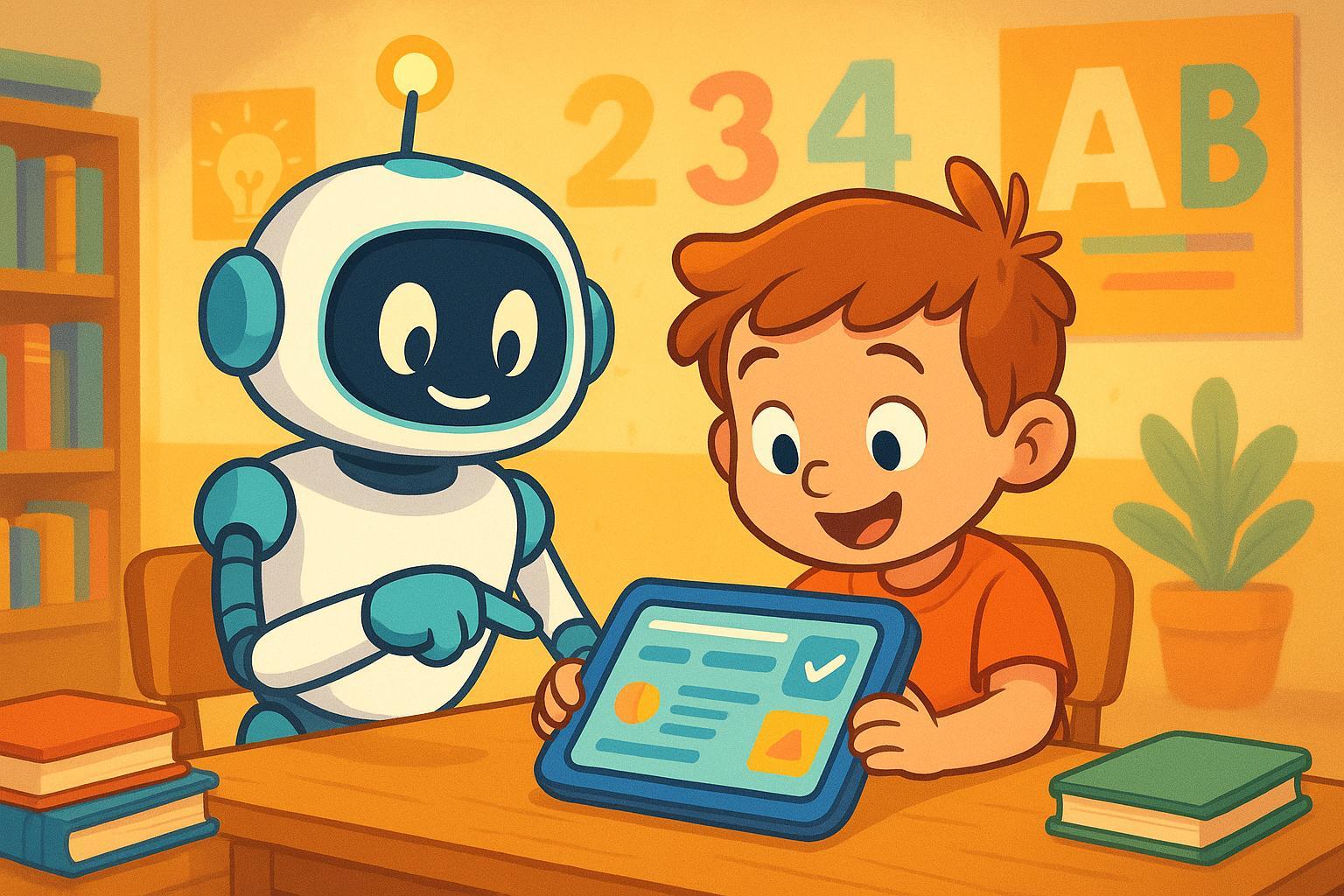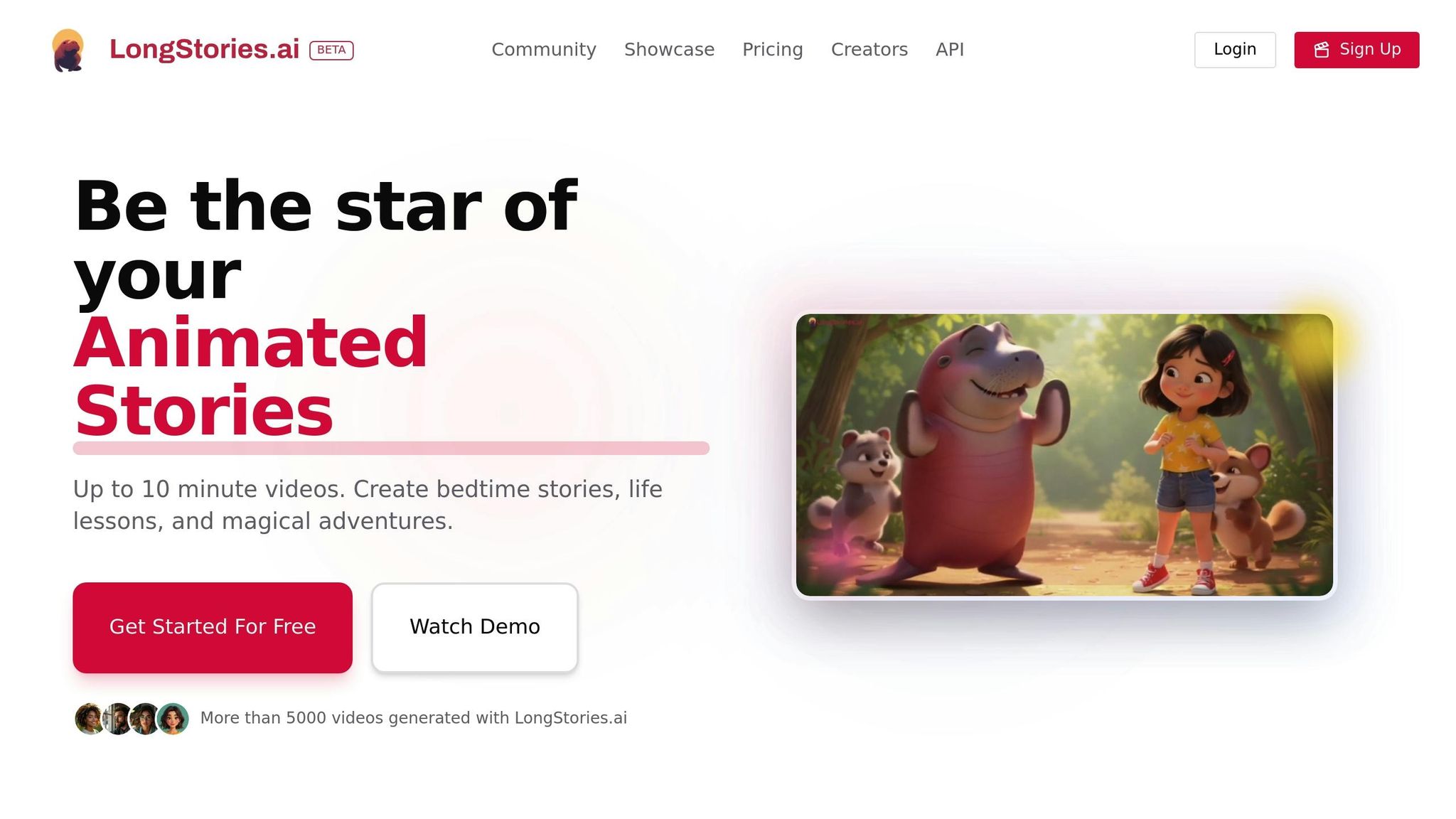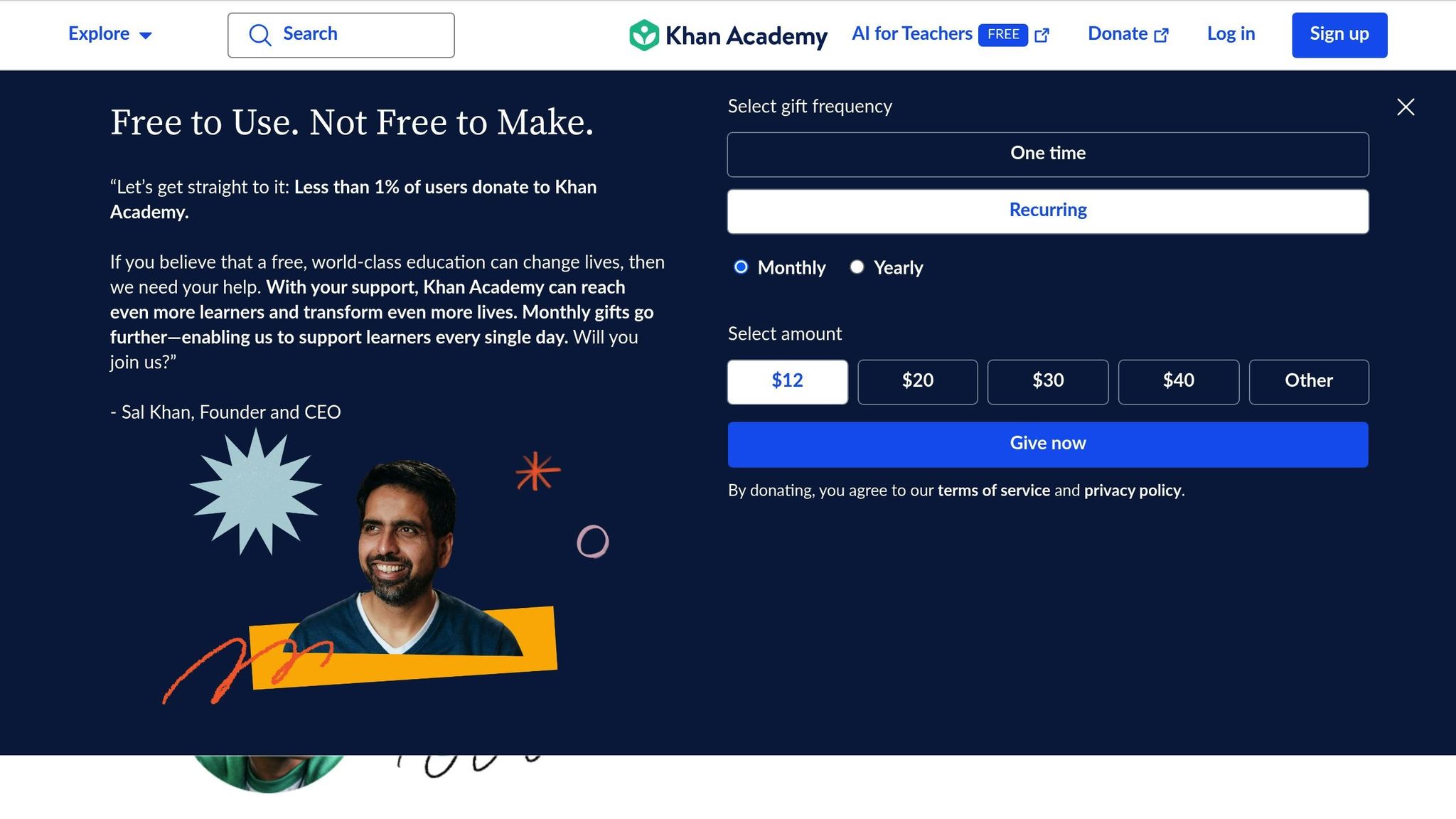
LongStories is constantly evolving as it finds its product-market fit. Features, pricing, and offerings are continuously being refined and updated. The information in this blog post reflects our understanding at the time of writing. Please always check LongStories.ai for the latest information about our products, features, and pricing, or contact us directly for the most current details.
How AI Personalizes Learning for Every Child
AI is transforming education by tailoring learning experiences to individual students' needs, abilities, and preferences. Here's how:
- Personalized Learning Paths: AI identifies strengths and weaknesses, adapting lessons in real time to match each student's learning style (visual, auditory, kinesthetic, or text-based).
- Improved Outcomes: Students in AI-driven programs have shown up to 62% better test scores, with tools like adaptive study plans and interactive content boosting engagement and understanding.
- Real-Time Feedback: AI provides instant, low-pressure assessments, helping students and teachers address challenges early.
- Global Reach: Platforms like LongStories.ai create custom, animated educational stories in 11 languages, making learning engaging and accessible.
- Challenges: Barriers include data privacy concerns, potential algorithm bias, high costs, and limited access for underserved communities.
AI is not about replacing teachers but enhancing their ability to provide tailored, effective education at scale. However, thoughtful implementation and addressing challenges like equity and security are key to its success.
How AI Identifies and Adapts to Learning Preferences
Data Collection and Analysis
AI systems gather student data from multiple sources to create detailed learning profiles. They monitor performance metrics like test scores, homework completion rates, and time spent on specific topics. Additionally, they track engagement data such as focus duration and how often students revisit materials. Even click patterns, response times, and types of errors are analyzed to uncover individual learning behaviors. For instance, if a student frequently struggles with word problems but excels at numerical calculations, the system can identify a preference for direct mathematical operations over language-heavy tasks.
A practical example of this comes from a university in Faisalabad, Pakistan. Researchers introduced an AI-driven adaptive learning platform across four courses involving 300 students. The platform collected extensive data on student interactions, study habits, and performance patterns. The results? A 25% improvement in grades, test scores, and engagement. This outcome was statistically validated with a p-value of 0.00045. By leveraging deep learning algorithms, AI can analyze these complex datasets to find subtle links between a student's learning style and their academic progress. This data-driven approach allows the system to continuously fine-tune each student's learning experience.
Adaptive Learning Algorithms
Once the data is in place, adaptive learning algorithms take over to personalize the educational experience in real time. These machine learning systems constantly evaluate a student's progress and adjust the curriculum accordingly. If a student masters a concept, the system moves them to more advanced material. On the flip side, if they struggle, the algorithm provides extra practice and alternative explanations. This tailored approach ensures that faster learners can advance without being held back, while those who need more time receive the support they require. Notably, 86% of 37 recent studies highlight the positive impact of adaptive learning systems in enhancing student outcomes.
Ongoing Assessment and Support
AI doesn't stop at initial personalization - it offers continuous assessment to refine the learning journey further. Unlike traditional tests, AI-powered evaluations are low-stakes and ongoing, giving a more accurate picture of a student's progress. These assessments deliver immediate, customized feedback that focuses on each student's strengths, challenges, and learning preferences. This proactive approach helps identify issues early, providing timely interventions to reinforce effective learning strategies.
Consider Ivy Tech Community College, where AI identified 16,000 at-risk students in just two weeks. The result? An impressive 98% of those students achieved at least a C grade. Similarly, at the University of Iowa, students using adaptive practice exams averaged 4.3 attempts, compared to just 1.2–1.6 attempts with static tests. Meanwhile, Stanford's M-Powering Teachers tool uses natural language processing to analyze classroom interactions. It identifies conversation patterns and provides feedback to improve teaching techniques. These examples show how AI-driven assessments and tools can transform both learning and teaching.
Customizing Educational Content for Different Learning Styles
Adapting to Different Learning Types
AI has an impressive ability to recognize the four main learning styles - visual, auditory, kinesthetic, and read/write - and create content tailored to each. For instance, visual learners benefit from tools like color-coded charts, mind maps, and graphic organizers, all generated by AI. Auditory learners, on the other hand, thrive with audio scripts and spoken explanations that match their learning pace. Kinesthetic learners engage best with hands-on activities and interactive simulations, while read/write learners prefer structured, text-based materials designed to suit their preferences.
AI can even evaluate factors like attention span, cognitive load, facial expressions, and emotions to pinpoint a student's preferred learning style. In one study, researchers used five-channel Emotive Insight EEG equipment to monitor the brain activity of 52 students as they explored four different learning scenarios: visual videos on artificial intelligence, auditory lectures about cloud reference models, text-based materials on induction motors, and kinesthetic exercises.
A particularly notable experiment achieved a 97.56% accuracy rate in detecting learning styles using a blending ensemble with the XGBoost model. With this level of precision, AI can make real-time adjustments to suit each student's natural learning preferences, transforming educational content into formats that truly resonate with the learner.
Interactive and Immersive Technologies
AI takes learning beyond static textbooks by turning content into dynamic, interactive experiences. Using Natural Language Processing (NLP), AI-powered systems can create chatbots and virtual assistants that answer student questions in real time, offering personalized explanations and guidance. Additionally, these tools deliver multi-format content - combining synchronized text, audio, and video - to meet diverse learning needs.
A great example of this is LongStories.ai, a platform that turns simple text prompts into fully voiced, animated cartoons where children become the main characters. In less than a minute, it generates personalized scripts, illustrations, voiceovers, and timing, producing shareable HD videos without requiring any video-editing skills. Since its launch, the platform has created over 5,000 video adventures, showing how AI can make learning both engaging and highly personal.
The results speak for themselves: personalized AI-assisted content has been shown to improve test scores in e-learning by 20%. By delivering information in formats that align with individual cognitive preferences - whether through animations, audio narration, or interactive tools - AI is redefining how education adapts to each learner.
Impact on Motivation and Engagement
Interactive and personalized formats not only enhance learning but also significantly boost student motivation and engagement. Students in personalized learning programs score 30% higher on standardized tests compared to those in traditional classrooms. Additionally, 75% of students report feeling more engaged in these environments. Schools that have adopted AI-driven personalized learning strategies have seen a 12% rise in attendance and a 15% drop in dropout rates.
"Identifying and understanding individual learning styles - such as visual, auditory, and kinesthetic - enhances educational outcomes by allowing tailored teaching methods that align with students' preferred ways of learning."
- Impact Teachers
There are plenty of real-world examples to back this up. In one California school district, personalized learning programs helped more students meet grade-level standards and reduced absenteeism. Meanwhile, a Texas school that invested $4,000 per student in AI-powered learning tools saw a 35% improvement in math skills in just a few months. By making learning 50% more engaging through customization, AI reduces cognitive barriers and turns education into a truly individualized experience.
Practical Applications: AI in Educational Storytelling
How LongStories.ai Personalizes Learning

LongStories.ai is changing the way children learn by introducing a personalized touch to educational storytelling. This platform takes a simple text prompt and, in under a minute, turns it into a voiced, animated cartoon starring the child. This approach goes beyond generic content, creating a deeper connection with young learners.
The system uses AI to craft custom scripts, illustrations, and voiceovers, producing polished HD videos that are easy to share - no video-editing skills required. Since its launch, LongStories.ai has created over 5,000 video adventures, highlighting the growing demand for personalized learning experiences.
What sets LongStories.ai apart is its ability to tailor content to each child's unique learning needs. Parents and educators can adjust vocabulary, language preferences, and themes, allowing the AI to deliver lessons that resonate with a child's interests and developmental stage. This adaptability is at the heart of its standout features.
Features of LongStories.ai
The platform is packed with features designed with U.S. families and classrooms in mind. Its Educational AI Tellers include characters like Manny the Manatee for science topics, Carter the Job Reporter for career exploration, and Professor Time for history lessons. These guides ensure content stays engaging and age-appropriate.
LongStories.ai supports 11 languages and prioritizes safety with features like profanity filters, inappropriate content detection, and COPPA certification to protect children's privacy. It’s designed for K–12 students, covering ages 5 to 18.
Teachers also gain access to tools that help them track student progress, create assignments tailored to individual needs, and align content with curriculum standards. Pricing options cater to different needs, starting at $10 for families (3 stories), $10/month for teachers (up to 10 students), and offering enterprise plans for school districts.
"The fact that a wonderful story is created with just a few clicks is magical! My kids love the experience and I don't have to make up new stories anymore!" - Dima Broslavsky
sbb-itb-94859ad
Benefits and Challenges of AI-Personalized Learning
Benefits of AI in Education
AI-driven adaptive learning programs have delivered tangible results, with students showing a 62% improvement in test scores as AI customizes the curriculum based on individual learning patterns. For instance, a third-grader struggling with math might get extra practice problems, while a more advanced student could tackle higher-level challenges.
Another advantage is instant feedback. AI allows for real-time adjustments in teaching strategies, enabling teachers to address potential issues before they grow into bigger problems. This proactive approach helps create a more effective learning environment.
AI also plays a key role in making education more inclusive. By offering tools like language translation and visual aids, AI accommodates a wide range of learning styles and needs. These features not only help students succeed academically but also streamline administrative processes for educators.
On top of that, AI simplifies teachers' workloads by automating repetitive tasks. Over 60% of educators globally now rely on AI to handle routine responsibilities, giving them more time to focus on teaching.
Challenges to Consider
Despite its benefits, AI in education comes with its own set of hurdles. One major issue is data privacy and security. AI systems collect vast amounts of sensitive student data, making them potential targets for breaches.
Bias in AI algorithms is another pressing concern. If these systems are trained on biased data, they could unintentionally perpetuate inequalities, disadvantaging certain groups of students. This becomes especially problematic in diverse classrooms where fairness is critical.
The digital divide also limits the reach of AI's benefits. Students without reliable internet or modern devices are at a disadvantage, potentially widening existing achievement gaps.
Cost is yet another barrier. While basic generative AI tools for lesson planning might cost around $25 per month, more advanced adaptive learning systems can run into tens of thousands of dollars. For many schools with tight budgets, these expenses can be hard to justify.
Additionally, some teachers remain hesitant to embrace AI. A 2023 survey by Tyton Partners highlighted this gap: while 27% of students regularly used generative AI tools, only 9% of teachers did the same. Bridging this gap will require targeted professional development and ongoing support.
"We need to embrace these tools and integrate them into pedagogies and policies. Lockdown browsers, strict dismissal policies, and forbidding the use of these platforms is not a sustainable way forward."
– Nancy Gleeson, Associate Professor at New York University Abu Dhabi
Comparison Table of Pros and Cons
Balancing the benefits and challenges of AI is crucial to unlocking its potential in education. Here’s a quick overview:
| Benefits | Challenges |
|---|---|
| 62% improvement in test scores with adaptive learning programs | Risks to data privacy and security of student information |
| Real-time feedback for immediate learning adjustments | Bias in AI algorithms potentially affecting fairness |
| Accessibility tools for diverse learning needs | Limited access for students without reliable internet or devices |
| Automation of administrative tasks frees up teacher time | High costs, ranging from $25/month to tens of thousands of dollars |
| Customized learning pace for individual students | Teacher resistance and the need for training |
| Engaging, tailored content delivery | Risks of over-reliance on AI and academic misconduct |
The future of AI in education depends on finding the right balance. As one expert put it: "AI doesn't just make higher education more efficient - it makes it more responsive, proactive, and aligned with student needs". To fully realize its potential, schools will need to prioritize strong privacy measures, equitable access, and comprehensive teacher training.
Conclusion: The Future of Personalized Learning with AI
Key Takeaways
AI is reshaping education on a global scale, tailoring learning to individual needs. Currently, 65–70% of institutions and 86% of students are using AI tools. This widespread adoption highlights AI's ability to customize content and predict the best learning paths for each student.
While AI excels in areas like personalization and adaptive practice, educators remain essential for instilling values and deeper understanding.
"AI like ChatGPT and Khan Academy's Khanmigo can function as a personal tutor for every student and an assistant for every teacher. This isn't about replacing educators, it's about giving them superpowers to provide personalized learning at scale."
- Sal Khan, Founder of Khan Academy
Parents and teachers are key to ensuring that AI enhances learning while preserving core human values. AI can assist with tasks like homework and practice exercises, but it cannot teach integrity, perseverance, or compassion. Platforms such as LongStories.ai showcase how AI can elevate educational storytelling, turning basic prompts into fully animated, personalized adventures where children take center stage in their learning journeys.
These advancements pave the way for even greater changes in education.
Looking Ahead
The future of AI in education is poised for rapid growth, with the market projected to hit USD 127.2 billion by 2035, growing at an annual rate of 32.2%. This expansion will fuel advancements in hyper-personalization, where AI tutors adapt to students' emotions and learning styles in real time. Emerging technologies like emotion detection - allowing AI to sense frustration or excitement - and the integration of virtual reality promise to create immersive, customized educational experiences. Lifelong adaptive learning is also on the horizon, ensuring AI supports education at every stage of life.
As noted earlier, AI platforms are transforming education in real time. However, their success hinges on thoughtful and responsible implementation.
"Many schools recognize AI's rapid integration. Because it's spreading so fast, they can't come up with hard-and-fast rules because there are so many different situations. So, they set up guardrails instead to guide usage."
- Miguel Guhlin, Director of Professional Development at TCEA
Collaboration is critical. Parents should engage in conversations with their children about AI use and establish clear guidelines. Educators, on the other hand, must thoughtfully incorporate AI into their teaching, prioritizing critical thinking and holistic development.
"AI won't be around in a year or two years. It'll be around for the next 50, a hundred, a thousand years."
- Niall Browne, Senior Vice President and CISO at Palo Alto Networks
AI can help personalize learning in education industry, says Khan Academy CEO

FAQs
How does AI protect student data while personalizing learning experiences?
AI takes student data protection seriously by adhering to strict privacy standards and legal requirements, like those outlined by the U.S. Department of Education. These rules are designed to ensure AI is used responsibly while safeguarding sensitive information, such as Social Security numbers and health records.
To keep data secure, organizations routinely assess and manage the information they store, putting safeguards in place to prevent breaches or misuse. By maintaining transparency and complying with privacy laws, AI-powered tools can earn the trust of parents, educators, and students, all while providing tailored learning experiences.
How do AI-powered educational tools ensure fairness and avoid bias?
AI-driven educational tools take various steps to promote fairness and reduce bias. One key approach is training algorithms on diverse, representative datasets, which helps prevent skewed outcomes that might favor certain groups. Regular bias and fairness audits are also conducted to identify and address any imbalances. On top of that, explainable AI (XAI) is employed to ensure decision-making processes are clear and understandable.
Another essential strategy involves assembling multidisciplinary teams to oversee development. By bringing together experts from different fields, potential biases can be spotted and addressed early in the process. These efforts aim to create more inclusive learning environments, tailoring AI-driven solutions to meet students' needs without bias.
How can schools and educators manage the costs of using AI in classrooms?
Schools and educators can reduce the expense of adopting AI by prioritizing small, task-specific AI models. These models are designed to address specific needs and are more budget-friendly, requiring fewer resources while still providing reliable outcomes.
Another cost-saving approach is using AI to automate administrative tasks. By streamlining operations like scheduling, record-keeping, and communication, schools can cut down on operational costs. This frees up funds that can be redirected toward creating more personalized learning opportunities for students.
With these strategies, schools can integrate AI in a way that’s both effective and affordable, ensuring students gain access to tailored educational tools without straining financial resources.
